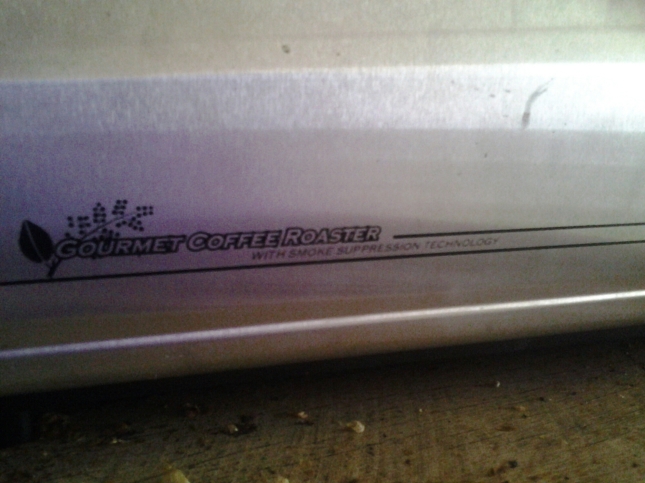I think that is good advice for life in general actually, but especially for my current project, coffee roasting!
I’ve mentioned before on this blog, but roasting is the part of the coffee process that I know least about. I have seen it done hundreds of times, attended pretty high level workshops on it and hung out in roasting companies for the PhD, but knowing what to do is definitely NOT the same as knowing how to do it. As with barista skills, it all comes with practice, but to learn properly, you have to Do, not just Watch. The reason I never got much hands on experience during my research was just that it is very difficult, and can go wrong so easily and when it does it is very expensive (in terms of wasted coffee beans) and potentially dangerous (fires).
Home roasting is possible with minimal equipment and some common sense (herein lies the rub). You can roast coffee badly and unevenly in a frying pan with a wooden spoon (except in addition to burnt beans, you also ruin the pan and fill the kitchen with smoke, fyi). The most effective way is using a air popcorn maker, but that restricts your roast capacity to about 50grams at a time. Roasting a standard sized bag of coffee with a popcorn machine takes nearly 2 hours and even if you acheive it, you might find you’ve burnt out the motor on the popcorn machine. I speak from experience on both these counts.
Now my cafe is up and running nicely and we have a lot of space in it, I bit the bullet and invested in a proper coffee roaster. It is lovely. And complicated. And programmable. I am so in love with it, I even did the unthinkable and read the manual first! Despite this vague preparation and along with some tips from friends who roast and my notes from the roasting workshops at Cafe Culture, my first few attempts were so good the fire alarm started cheering me on!! Cinnamon/light roast is relatively easy, Charbucks style oily blackness is very easy, tasty medium to dark roast is pretty damn difficult, and a bit scary.

But practice makes perfect, and after playing with the machine for a month (and wasting a huge amount of green coffee beans, unfortunately) I have got to the point where the coffee I roast is good enough to go in the cafe (in bags for home use, I couldn’t keep up with the amount needed for drinks in the cafe). Here is what I’ve learned so far:
1. Always plan 15 seconds ahead.
This is the length of time for the machine to go from heating to cooling. So even after you hit stop, it will carry on roasting for 15 seconds longer. 15 seconds is a long time for coffee. Not even Starbucks Bold roast (ie, black) goes beyond 10 seconds past the 2nd crack. I’ve found the difference between delicious and burnt is 3 seconds.
There is always smoke.
3. Roasting is an inexact science and a precise art.
As complex as my programming and roast profiles may be, no matter how precisely i set the time and temperatures, the vast majority of the time I am relying on what it looks like and what I can hear. Each type of coffee behaves differently (ie: coffee beans from Brazil are different from SHG Nicaraguan etc) and so you set the profile with an educated guess, listen out for the cracks, then watch it like a hawk until it looks right – or rather, until about 15 seconds before it looks right.
4. Unless you can compare, you turn towards the light.
Partly as a result of the Fear of Fire Alarm (for the record, there have been no actual fires, just enough smoke to trigger the alarm), my roasts have tended to get lighter and lighter the more I do. It’s strange, but it seems my version of what “looks right” is less and less brave every time. So, it’s best to have a sample of a good batch next to you to compare!
5. Consistency is king, but beans are variable.
Following on from the last points, I think to call yourself a good roaster, you must be able to produce the same results over and over. I am getting there, but it is not as easy as it sounds. Even after I carefully write down the exact formula and roast profile and repeat the roast to the exact second, I still occasionally get ‘anomalous’ results. Sometimes, the beans just misbehave. At the moment, I can’t figure out any reason for it, but this is something I hope to learn as I continue!

Experiments will continue, and I am now confident enough to try roasting blends too (a whole other kettle of fish). Watch this space! And of course, if you are local, pick up a bag of beans in Dr. Coffee’s Cafe and let me know what you think!

